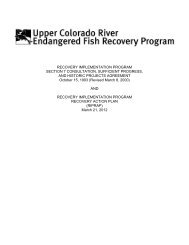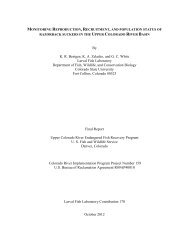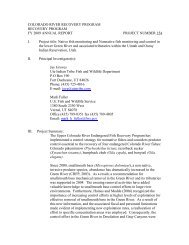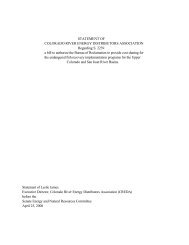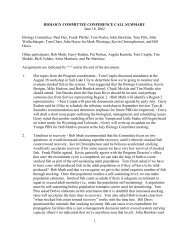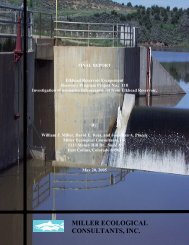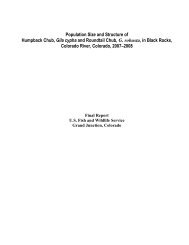A marked decline in populations <strong>of</strong> razorback suckers can be attributed to construction <strong>of</strong> damsand reservoirs, introduction <strong>of</strong> nonnative fishes, and removal <strong>of</strong> large quantities <strong>of</strong> water from theColorado River system. Dams on the mainstem Colorado River and its major tributaries havesegmented the river system, blocking migration routes. Dams also have drastically altered flows,temperatures, and channel geomorphology. These changes have modified habitats in many areasso that they are no longer suitable <strong>for</strong> breeding, feeding, or sheltering. Major changes in speciescomposition have occurred due to the introduction <strong>of</strong> numerous nonnative fishes, many <strong>of</strong> whichhave thrived due to man-induced changes to the natural riverine system.Critical habitat was designated in 1994 within the 100-year floodplain <strong>of</strong> the razorback sucker'shistorical range in the following area <strong>of</strong> the upper Colorado River (59 F.R. 13374). The primaryconstituent elements are the same as critical habitat <strong>for</strong> Colorado pikeminnow describedpreviously.Colorado, Mesa and Garfield Counties. The Colorado River and its 100-year floodplainfrom Colorado River Bridge at exit 90 north <strong>of</strong>f Interstate 70 in T. 6 S., R. 93 W., section16 (6th Principal Meridian) to Westwater Canyon in T. 20 S., R. 25 E., section 12 (SaltLake Meridian) including the Gunnison River and its 100-year floodplain from theRedlands Diversion Dam in T. 1 S., R. 1 W., section 27 (Ute Meridian) to the confluencewith the Colorado River in T. 1 S., R. 1 W., section 22 (Ute Meridian).Colorado, Delta and Mesa Counties. The Gunnison River and its 100-year floodplainfrom the confluence with the Uncompahgre River in T. 15 S., R. 96 W., section 11 (6thPrincipal Meridian) to Redlands Diversion Dam in T. 1 S., R. 1 W., section 27 (UteMeridian).Utah, Grand, San Juan, Wayne, and Garfield Counties. The Colorado River and its100-year floodplain from Westwater Canyon in T. 20 S., R. 25 E., section 12 (Salt LakeMeridian) to full pool elevation, upstream <strong>of</strong> North Wash, and including the Dirty Devilarm <strong>of</strong> Lake Powell in T. 33 S., R. 14 E., section 29 (Salt Lake Meridian).Status and DistributionThe current distribution and abundance <strong>of</strong> the razorback sucker have been significantly reducedthroughout the Colorado River system, due to lack <strong>of</strong> recruitment to the adult population (McAda1987; McAda and Wydoski 1980; Holden and Stalnaker 1975; Minckley 1983; Marsh andMinckley 1989; Tyus 1987). The only substantial population exists in Lake Mohave with anestimated population <strong>of</strong> 25,000 adult razorback suckers in 1995 (Chuck Minckley pers. com.)down from an earlier estimate <strong>of</strong> 60,000 adult razorback suckers (Minckley et al. 1991). They donot appear to be successfully recruiting. While limited numbers <strong>of</strong> razorback suckers persist inother locations in the lower Colorado River, they are considered rare or incidental and may becontinuing to decline.29
In the Upper Basin, above Glen Canyon Dam, razorback suckers are found in limited numbers inboth lentic and lotic environments. The largest population <strong>of</strong> razorback suckers in the UpperBasin is found in the upper Green River and lower Yampa River (Tyus 1987). Lanigan and Tyus(1989) estimated that from 758 to 1,138 razorback suckers inhabit the upper Green River.Modde et al. (1996) report no significant decrease in the population between 1982 and 1992, andthe continued presence <strong>of</strong> fish smaller than 480 mm during the study period suggest some level <strong>of</strong>recruitment. In the Colorado River, most razorback suckers occur in the Grand Valley area nearGrand Junction, Colorado; however, they are increasingly rare. Osmundson and Kaeding (1991)report that the number <strong>of</strong> razorback sucker captures in the Grand Junction area has declineddramatically since 1974. In 1991 and 1992, 28 adult razorback suckers were collected fromisolated ponds adjacent to the Colorado River near De Beque, Colorado (Burdick 1992). Theexisting habitat has been modified to the extent that it impairs essential behavior patterns, such asbreeding, feeding, and sheltering.Razorback suckers are in imminent danger <strong>of</strong> extirpation in the wild. The razorback sucker waslisted as endangered October 23, 1991 (56 FR 54957). As Bestgen (1990) pointed out:"Reasons <strong>for</strong> decline <strong>of</strong> most native fishes in the Colorado River Basin have beenattributed to habitat loss due to construction <strong>of</strong> mainstream dams and subsequentinterruption or alteration <strong>of</strong> natural flow and physio-chemical regimes, inundation <strong>of</strong> riverreaches by reservoirs, channelization, water quality degradation, introduction <strong>of</strong> nonnativefish species and resulting competitive interactions or predation, and other man-induceddisturbances (Miller 1961, Joseph et al. 1977, Behnke and Benson 1983, Carlson andMuth 1989, Tyus and Karp 1989). These factors are almost certainly not mutuallyexclusive, there<strong>for</strong>e it is <strong>of</strong>ten difficult to determine exact cause and effect relationships."The virtual absence <strong>of</strong> any recruitment suggests a combination <strong>of</strong> biological, physical, and/orchemical factors that may be affecting the survival and recruitment <strong>of</strong> early life stages <strong>of</strong>razorback suckers. Within the Upper Basin, recovery ef<strong>for</strong>ts endorsed by the Recovery Programinclude the capture and removal <strong>of</strong> razorback suckers from all known locations <strong>for</strong> geneticanalyses and development <strong>of</strong> discrete brood stocks if necessary. These measures have beenundertaken to develop refugia populations <strong>of</strong> the razorback sucker from the same geneticparentage as their wild counterparts such that, if these fish are genetically unique by subbasin orindividual population, then separate stocks will be available <strong>for</strong> future augmentation. Suchaugmentation may be a necessary step to prevent the extinction <strong>of</strong> razorback suckers in the UpperBasin.Life HistoryMcAda and Wydoski (1980) and Tyus (1987) reported springtime aggregations <strong>of</strong> razorbacksuckers in <strong>of</strong>f-channel habitats and tributaries; such aggregations are believed to be associatedwith reproductive activities. Tyus and Karp (1990) and Osmundson and Kaeding (1991) reported<strong>of</strong>f-channel habitats to be much warmer than the mainstem river and that razorback suckers30
- Page 1 and 2: FINAL PROGRAMMATIC BIOLOGICAL OPINI
- Page 3 and 4: INCIDENTAL TAKE ...................
- Page 5 and 6: 2" Reclamation’s portion of 120,0
- Page 7 and 8: On January 21-22, 1988, the Secreta
- Page 9 and 10: funding component of the Recovery P
- Page 11 and 12: 81. Habitat Protection ElementGener
- Page 13 and 14: Also, the Service and the Colorado
- Page 15 and 16: Table 1. The estimated benefits in
- Page 17 and 18: through recovery efforts that will
- Page 19 and 20: native fishes. Also, some species o
- Page 21 and 22: “new” depletions. This would in
- Page 23 and 24: Based on early fish collection reco
- Page 25 and 26: infrequent pulsed recruitment make
- Page 27 and 28: Area, in the Loma to Black Rocks re
- Page 29 and 30: 26Figure 1. Distribution of adult C
- Page 31: during high flows. Some of the pike
- Page 35 and 36: 32Populations DynamicsThere are no
- Page 37 and 38: in low velocity shorelines and back
- Page 39 and 40: 36IMPORTANCE OF THE 15-MILE REACHTh
- Page 41 and 42: occur in the 15-Mile Reach). Provid
- Page 43 and 44: Applying the above regulations, the
- Page 45 and 46: in a river basin. While the model i
- Page 47 and 48: 44Factors Affecting Species Environ
- Page 49 and 50: 46To determine conditions with wate
- Page 51 and 52: 48140001200010000CFS800060004000200
- Page 53 and 54: 50CFS240002200020000180001600014000
- Page 55 and 56: 52CFS280002600024000220002000018000
- Page 57 and 58: Release and protection of surplus H
- Page 59 and 60: 56CFS500045004000350030002500200015
- Page 61 and 62: The formation of a variety of chann
- Page 63 and 64: options will be determined through
- Page 65 and 66: Passage at the Price-Stubb Diversio
- Page 67 and 68: species. Recent population estimate
- Page 69 and 70: the endangered fishes. Ongoing Reco
- Page 71 and 72: 68the Colorado pikeminnow, razorbac
- Page 73 and 74: 70There are no current population e
- Page 75 and 76: additional reasonable and prudent m
- Page 77 and 78: The Recovery Action Plan is an adap
- Page 79 and 80: 76actions have all been completed a
- Page 81 and 82: 78LITERATURE CITEDAbbott, C. C. 186
- Page 83 and 84:
80the Upper Colorado River Basin, P
- Page 85 and 86:
Kaeding, L. R., and D. B. Osmundson
- Page 87 and 88:
Minckley, W. L. 1983. Status of the
- Page 89 and 90:
Pitlick, J., and M. Van Steeter. 19
- Page 91 and 92:
Tyus, H. M., B. D. Burdick, R. A. V
- Page 93:
Wick, E. J. 1997. Physical processe



